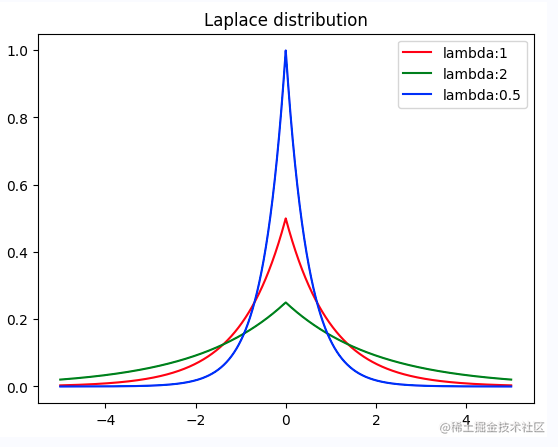import numbers
import numpy as npimport paddlefrom paddle.distribution import distributionfrom paddle.fluid import framework as frameworkclass Laplace(distribution.Distribution): r""" Creates a Laplace distribution parameterized by :attr:`loc` and :attr:`scale`. Mathematical details The probability density function (pdf) is .. math:: pdf(x; \mu, \sigma) = \frac{1}{2 * \sigma} * e^{\frac {-|x - \mu|}{\sigma}} In the above equation: * :math:`loc = \mu`: is the location parameter. * :math:`scale = \sigma`: is the scale parameter. Args: loc (scalar|Tensor): The mean of the distribution. scale (scalar|Tensor): The scale of the distribution. name(str, optional): Name for the operation (optional, default is None). For more information, please refer to :ref:`api_guide_Name`. Examples: .. code-block:: python import paddle m = paddle.distribution.Laplace(paddle.to_tensor([0.0]), paddle.to_tensor([1.0])) m.sample() # Laplace distributed with loc=0, scale=1 # Tensor(shape=[1], dtype=float32, place=Place(cpu), stop_gradient=True, # [3.68546247]) """
def __init__(self, loc, scale): if not isinstance(loc, (numbers.Real, framework.Variable)): raise TypeError( f"Expected type of loc is Real|Variable, but got {type(loc)}")
if not isinstance(scale, (numbers.Real, framework.Variable)): raise TypeError( f"Expected type of scale is Real|Variable, but got {type(scale)}" )
if isinstance(loc, numbers.Real): loc = paddle.full(shape=(), fill_value=loc)
if isinstance(scale, numbers.Real): scale = paddle.full(shape=(), fill_value=scale)
if (len(scale.shape) > 0 or len(loc.shape) > 0) and (loc.dtype == scale.dtype): self.loc, self.scale = paddle.broadcast_tensors([loc, scale]) else: self.loc, self.scale = loc, scale
super(Laplace, self).__init__(self.loc.shape)
@property def mean(self): """Mean of distribution. Returns: Tensor: The mean value. """ return self.loc
@property def stddev(self): """Standard deviation. The stddev is .. math:: stddev = \sqrt{2} * \sigma In the above equation: * :math:`scale = \sigma`: is the scale parameter. Returns: Tensor: The std value. """ return (2**0.5) * self.scale
@property def variance(self): """Variance of distribution. The variance is .. math:: variance = 2 * \sigma^2 In the above equation: * :math:`scale = \sigma`: is the scale parameter. Returns: Tensor: The variance value. """ return self.stddev.pow(2)
def _validate_value(self, value): """Argument dimension check for distribution methods such as `log_prob`, `cdf` and `icdf`. Args: value (Tensor|Scalar): The input value, which can be a scalar or a tensor. Returns: loc, scale, value: The broadcasted loc, scale and value, with the same dimension and data type. """ if isinstance(value, numbers.Real): value = paddle.full(shape=(), fill_value=value) if value.dtype != self.scale.dtype: value = paddle.cast(value, self.scale.dtype) if len(self.scale.shape) > 0 or len(self.loc.shape) > 0 or len( value.shape) > 0: loc, scale, value = paddle.broadcast_tensors( [self.loc, self.scale, value]) else: loc, scale = self.loc, self.scale
return loc, scale, value
def log_prob(self, value): """Log probability density/mass function. The log_prob is .. math:: log\_prob(value) = \frac{-log(2 * \sigma) - |value - \mu|}{\sigma} In the above equation: * :math:`loc = \mu`: is the location parameter. * :math:`scale = \sigma`: is the scale parameter. Args: value (Tensor|Scalar): The input value, can be a scalar or a tensor. Returns: Tensor: The log probability, whose data type is same with value. Examples: .. code-block:: python import paddle m = paddle.distribution.Laplace(paddle.to_tensor([0.0]), paddle.to_tensor([1.0])) value = paddle.to_tensor([0.1]) m.log_prob(value) # Tensor(shape=[1], dtype=float32, place=Place(cpu), stop_gradient=True, # [-0.79314721]) """ loc, scale, value = self._validate_value(value) log_scale = -paddle.log(2 * scale)
return (log_scale - paddle.abs(value - loc) / scale)
def entropy(self): """Entropy of Laplace distribution. The entropy is: .. math:: entropy() = 1 + log(2 * \sigma) In the above equation: * :math:`scale = \sigma`: is the scale parameter. Returns: The entropy of distribution. Examples: .. code-block:: python import paddle m = paddle.distribution.Laplace(paddle.to_tensor([0.0]), paddle.to_tensor([1.0])) m.entropy() # Tensor(shape=[1], dtype=float32, place=Place(cpu), stop_gradient=True, # [1.69314718]) """ return 1 + paddle.log(2 * self.scale)
def cdf(self, value): """Cumulative distribution function. The cdf is .. math:: cdf(value) = 0.5 - 0.5 * sign(value - \mu) * e^\frac{-|(\mu - \sigma)|}{\sigma} In the above equation: * :math:`loc = \mu`: is the location parameter. * :math:`scale = \sigma`: is the scale parameter. Args: value (Tensor): The value to be evaluated. Returns: Tensor: The cumulative probability of value. Examples: .. code-block:: python import paddle m = paddle.distribution.Laplace(paddle.to_tensor([0.0]), paddle.to_tensor([1.0])) value = paddle.to_tensor([0.1]) m.cdf(value) # Tensor(shape=[1], dtype=float32, place=Place(cpu), stop_gradient=True, # [0.54758132]) """ loc, scale, value = self._validate_value(value) iterm = (0.5 * (value - loc).sign() * paddle.expm1(-(value - loc).abs() / scale))
return 0.5 - iterm
def icdf(self, value): """Inverse Cumulative distribution function. The icdf is .. math:: cdf^{-1}(value)= \mu - \sigma * sign(value - 0.5) * ln(1 - 2 * |value-0.5|) In the above equation: * :math:`loc = \mu`: is the location parameter. * :math:`scale = \sigma`: is the scale parameter. Args: value (Tensor): The value to be evaluated. Returns: Tensor: The cumulative probability of value. Examples: .. code-block:: python import paddle m = paddle.distribution.Laplace(paddle.to_tensor([0.0]), paddle.to_tensor([1.0])) value = paddle.to_tensor([0.1]) m.icdf(value) # Tensor(shape=[1], dtype=float32, place=Place(cpu), stop_gradient=True, # [-1.60943794]) """ loc, scale, value = self._validate_value(value) term = value - 0.5
return (loc - scale * (term).sign() * paddle.log1p(-2 * term.abs()))
def sample(self, shape=()): """Generate samples of the specified shape. Args: shape(tuple[int]): The shape of generated samples. Returns: Tensor: A sample tensor that fits the Laplace distribution. Examples: .. code-block:: python import paddle m = paddle.distribution.Laplace(paddle.to_tensor([0.0]), paddle.to_tensor([1.0])) m.sample() # Laplace distributed with loc=0, scale=1 # Tensor(shape=[1], dtype=float32, place=Place(cpu), stop_gradient=True, # [3.68546247]) """ if not isinstance(shape, tuple): raise TypeError( f'Expected shape should be tuple[int], but got {type(shape)}')
with paddle.no_grad(): return self.rsample(shape)
def rsample(self, shape): """Reparameterized sample. Args: shape(tuple[int]): The shape of generated samples. Returns: Tensor: A sample tensor that fits the Laplace distribution. Examples: .. code-block:: python import paddle m = paddle.distribution.Laplace(paddle.to_tensor([0.0]), paddle.to_tensor([1.0])) m.rsample((1,)) # Laplace distributed with loc=0, scale=1 # Tensor(shape=[1, 1], dtype=float32, place=Place(cpu), stop_gradient=True, # [[0.04337667]]) """
eps = self._get_eps() shape = self._extend_shape(shape) or (1, ) uniform = paddle.uniform(shape=shape, min=float(np.nextafter(-1, 1)) + eps / 2, max=1. - eps / 2, dtype=self.loc.dtype)
if len(self.scale.shape) == 0 and len(self.loc.shape) == 0: loc, scale, uniform = paddle.broadcast_tensors( [self.loc, self.scale, uniform]) else: loc, scale = self.loc, self.scale
return (loc - scale * uniform.sign() * paddle.log1p(-uniform.abs()))
def _get_eps(self): """ Get the eps of certain data type. Note: Since paddle.finfo is temporarily unavailable, we use hard-coding style to get eps value. Returns: Float: An eps value by different data types. """ eps = 1.19209e-07 if (self.loc.dtype == paddle.float64 or self.loc.dtype == paddle.complex128): eps = 2.22045e-16
return eps
def kl_divergence(self, other): """Calculate the KL divergence KL(self || other) with two Laplace instances. The kl_divergence between two Laplace distribution is .. math:: KL\_divergence(\mu_0, \sigma_0; \mu_1, \sigma_1) = 0.5 (ratio^2 + (\frac{diff}{\sigma_1})^2 - 1 - 2 \ln {ratio}) .. math:: ratio = \frac{\sigma_0}{\sigma_1} .. math:: diff = \mu_1 - \mu_0 In the above equation: * :math:`loc = \mu`: is the location parameter of self. * :math:`scale = \sigma`: is the scale parameter of self. * :math:`loc = \mu_1`: is the location parameter of the reference Laplace distribution. * :math:`scale = \sigma_1`: is the scale parameter of the reference Laplace distribution. * :math:`ratio`: is the ratio between the two distribution. * :math:`diff`: is the difference between the two distribution. Args: other (Laplace): An instance of Laplace. Returns: Tensor: The kl-divergence between two laplace distributions. Examples: .. code-block:: python import paddle m1 = paddle.distribution.Laplace(paddle.to_tensor([0.0]), paddle.to_tensor([1.0])) m2 = paddle.distribution.Laplace(paddle.to_tensor([1.0]), paddle.to_tensor([0.5])) m1.kl_divergence(m2) # Tensor(shape=[1], dtype=float32, place=Place(cpu), stop_gradient=True, # [1.04261160]) """
var_ratio = other.scale / self.scale t = paddle.abs(self.loc - other.loc) term1 = ((self.scale * paddle.exp(-t / self.scale) + t) / other.scale) term2 = paddle.log(var_ratio)
return term1 + term2 - 1
















评论